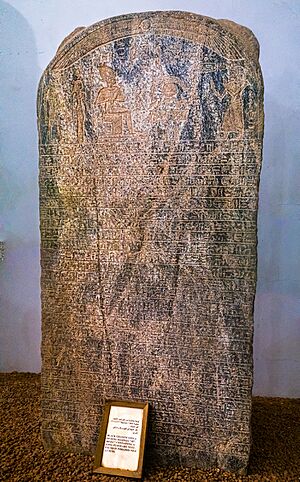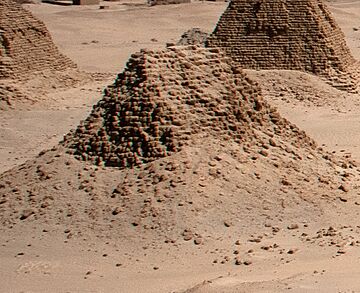Siaspiqa facts for kids
Quick facts for kids Siaspiqa |
|
|---|---|
| Siaspiqo, Siaspi-qo, Si'aspiqo, Sa'asheriqa. | |

Granite stela of Siaspiqa originally from his pyramid at Nuri, now on display in the National Museum of Sudan
|
|
| Kushite king of Meroë | |
| Reign | c. 487–468 BC |
| Predecessor | Amaniastabarqa |
| Successor | Nasakhma |
| Consort | possibly queen Pi'ankhqewqa |
| Burial | Nuri, pyramid 4 |
Siaspiqa (also called Si'aspiqo) was a king of the ancient Kushite kingdom of Meroë. He ruled for almost twenty years around 487–468 BC. We don't know much about what Siaspiqa did during his reign. Most of what we know comes from his pyramid, called Nuri 4, in Nuri. Inside his pyramid and its small chapel, archaeologists found stone slabs (called stelas) with his name. They also found many valuable items, showing he had a very rich burial.
We are not sure about Siaspiqa's family connections. It's unclear how he was related to the king before him, Amaniastabarqa, or the king after him, Nasakhma. We also don't know for sure who his wife was. Some experts think it might have been Queen Pi'ankhqewqa, who was buried in a nearby pyramid, Nuri 29.
Contents
Who Was Siaspiqa?
Siaspiqa is known by two, or possibly three, different names. His main name was Siaspiqa. He also had a special "throne name" called Segerehtawyre. This name means "Ra is the pacifier of the Two Lands".
There's another name, Semenkheretnetjer, that might have been his throne name too. However, some experts think this name might describe a special ceremony. This ceremony was likely connected to building his pyramid. It might mean "Cleansing the necropolis" (a necropolis is a large ancient cemetery).
The name Segerehtawyre, meaning "pacifier of the Two Lands," is interesting. It could mean Siaspiqa wanted to unite or make peace with Ancient Egypt. Or, "Two Lands" might just refer to the lands he ruled in Kush. This name might also be similar to a name used by an earlier Kushite king, Senkamanisken.
Siaspiqa's Place in History
We don't know who Siaspiqa's parents were. Historians believe he became king after Amaniastabarqa. This is based on where their pyramids are located next to each other. The same idea suggests that Nasakhma became king after Siaspiqa.
Experts have suggested different dates for Siaspiqa's rule. These include 489–471 BC, 487–468 BC, and 478–458 BC. This means he likely ruled at the same time as Xerxes I, a powerful emperor of the Achaemenid Empire. Xerxes I was also the ruler of Egypt during that period.
Royal Family Life
Archaeologists haven't found any family members of Siaspiqa for sure. Two archaeologists, Dows Dunham and Laming Macadam, thought that Queen Piankhqewqa might have been his wife. She was buried in pyramid Nuri 29.
Discoveries from Siaspiqa's Reign
We know a lot about Siaspiqa because many items with his name have been found. Most of these discoveries come from his pyramid at Nuri.
Items from Nuri Pyramid
- A special jar used for pouring liquids (a libation jar) was found in his pyramid's chapel. It has his throne name and main name on it.
- A heart-scarab, which is a beetle-shaped amulet, was also found.
- A large granite stone slab (a stela) was discovered. It has a special text for the dead and shows Siaspiqa worshiping the god Osiris. Osiris is shown sitting on a throne with the gods Isis and Anubis. This stela was once covered with gold leaf at the top.
- Another granite offering table, probably from his chapel, was found in a Coptic church nearby. It was used as building material there.
- Two more granite offering stands with his royal names were found in the church's doorway and stairs. These items are now in the National Museum of Sudan in Khartoum.
Archaeological Finds
Siaspiqa's tomb, Nuri 4, was explored in 1917. This was done by a team from Harvard University and the Boston Museum of Fine Arts. They found many broken faience shawabtis. These were small statues meant to serve the king in the afterlife. The top part of one of these statues is now in the Museum of Fine Arts, Boston.
Other finds from these digs include:
- A small cylinder made of beryl (a type of gemstone).
- A tiny gold pendant shaped like a bird, representing a person's Ba soul (their personality or spirit).
- Golden beaded discs, pieces of gold foil, a gold flower shape (rosette), and two plain gold finger rings. These items might have belonged to Siaspiqa.
- In 1922, another excavation found a gold plaque. This was part of a foundation deposit in his pyramid. Foundation deposits were items buried when a building was started. This plaque is now in the British Museum.
Archaeologists also found pieces of amazonite, slate, and travertine. These were used as inlays to decorate Siaspiqa's sarcophagus (a stone coffin). A small clay offering vessel and cup were also found. A piece of an alabaster canopic jar rim was discovered too. Canopic jars were used to store organs after mummification. This might be the last time such a jar was used for a king, but it's possible it was placed there later.
Siaspiqa's name also appears on special objects given to the temple of Amun in Meroë.
Siaspiqa's Pyramid
Siaspiqa was buried in a pyramid he built for himself at the royal burial ground of Nuri. It is known as pyramid Nuri 4. The pyramid is made of sandstone blocks. It has a base course and a sandstone wall around it. The pyramid is too damaged to know its original height. It covers an area of about 26.95 square meters (290 square feet).
Next to the pyramid's southeast side is a small chapel. This chapel held the main granite offering stela. The walls of the chapel might have been covered in white plaster. They may have had carved hieroglyphs painted in red and gold.
Inside the Pyramid
The pyramid was built over three underground rooms. These rooms are on the same level and are connected. You enter them from a long hallway. This hallway starts with 49 stairs at ground level. The entrance to the hallway is almost 40 meters (130 feet) in front of the chapel.
The hallway is still blocked by a stone plug. Thieves got into the pyramid by digging a vertical hole from the ground. This hole led directly behind the plug.
- The first room is about 4.9 by 4 meters (16 by 13 feet) with a paved floor.
- The second room is about 5.8 by 5.9 meters (19 by 19 feet). Its floor is not paved.
- The third and largest room is about 7.50 by 6.65 meters (24.6 by 21.8 feet). It has a paved floor made of sandstone and granite. The walls of this room have no carvings or writings.
The burial room likely held one or two wooden coffins for the king. These coffins were shaped like a human body. They were richly decorated with materials like obsidian, Lapis lazuli, slate, and alabaster. Four small pieces that might be from a human skull were also found there.


